The difference between induction and repression of operon is mainly characterized by the factors like regulation and the fundamental role of both systems. The operon system in prokaryotes regulates the expression of enzymes necessary to turn on or off the metabolic pathway.
The regulatory gene of the inducible operon forms an active repressor protein whose binding affinity towards the operator region is mediated by the inducer. An inducer functions as an anti-repressor, whose presence induces the expression of enzymes and suppresses the activity of the repressor protein.
Oppositely, the regulatory gene of the repressible operon synthesizes apo-repressor protein, whose activity is controlled by the corepressor. The corepressor functions as an effector molecule, whose presence activates the apo-repressor protein and represses the enzyme synthesis. The induction system significantly turns on the operon system by allowing the association of inducer and repressor protein.
In contrast, the repression system switches off the operon system through a complex formed by the combination of corepressor and apo-repressor protein. This post discusses the key differences between induction and repression, along with the comparison chart and definitions of the two.
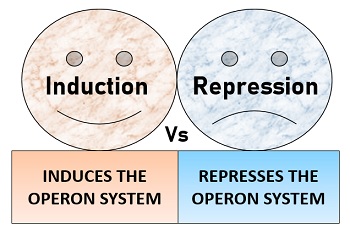
Content: Induction Vs Repression
Comparison Chart
| Properties | Induction | Repression |
|---|---|---|
| Meaning | The meaning of induction system states that it will induce the gene expression via an inducer | The meaning of repression system states that it will suppress the gene expression via a corepressor |
| Regulation | The operon system regulates the synthesis of enzymes that are stimulated by the addition of inducer | The operon system suppresses the enzyme synthesis, which is facilitated by the existing end-product or corepressor molecules |
| Key element | Inducer or anti-repressor | Corepressor or effector molecule |
| Mechanism | Inducer inactivates the repressor protein by preventing the attachment of a repressor to the operator region | Corepressor activates the apo-repressor protein (inactive) and allows the attachment of an active repressor to the operator region |
| Effect on the control system | Mediates movement of the RNA polymerase along the control system, i.e. promoter and operator region | Blocks the movement of RNA polymerase along the promoter and operator region |
| Effect on structural genes | It initiates the expression of structural genes | It inhibits the expression of structural genes |
| Overall impact | An induction system activates or turns on the whole operon system through an adequate supply of the inducer metabolites | A repression system terminates or switches off the entire operon system under an adequate level of corepressor molecules |
| Operon system | The genetic system regulated by the presence or absence of an inducer is called inducible operon | The genetic system regulated by the presence or absence of a corepressor is called repressible operon |
| Enzyme | Enzymes synthesis stimulated by the addition of inducer metabolites are termed as inducible enzymes | Enzymes synthesis inhibited by the addition of corepressor molecules are termed as repressible enzymes |
| Example | Lactose operon | Tryptophan operon |
| Metabolic pathway | It operates a catabolic synthesis | It operates an anabolic synthesis |
Definition of Induction
The inducible operon stimulates enzyme synthesis by supplying enough inducer molecules or substrates to prokaryotic cells. For instance, β-galactosidase is an enzyme that hydrolyzes substrate (lactose) into simple products (glucose and galactose) via an inducer (allolactose).
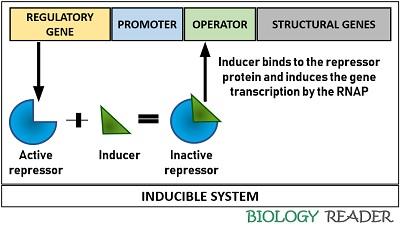
Here in the above diagram, we could see that the inducer (allolactose) initiates the enzyme synthesis necessary for the hydrolysis of the substrate (lactose) by suppressing the active repressor protein. By ceasing the supply of lactose to E. coli cells, the β galactosidase synthesis will also halt, and vice versa. Therefore, the lactose operon is the best example to study the induction system, where the addition of lactose increases the synthesis of β galactosidase to the rate of 10,000 times.
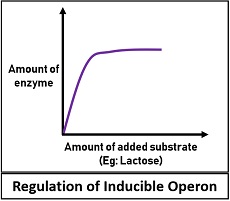
Enzymes whose synthesis gets increased by the increasing concentration of inducer molecules are known as inducible enzymes. A genetic or a gene system that regulates the enzyme synthesis via an inducer is termed an inducible operon. Thus, inducible operon conducts the catabolic pathway like catalysis of oligosaccharide into simple sugar.
Definition of Repression
The repressible operon ceases the enzyme synthesis by providing the appropriate concentration of particular amino acids to prokaryotic cells. For instance, tryptophan is an amino acid whose supply can repress the production of tryptophan synthesizing enzymes.
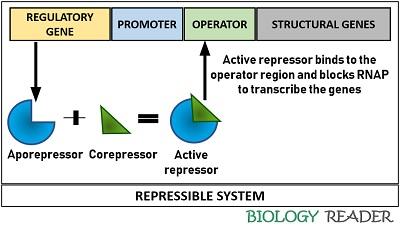
Here in the above figure, we could see that the tryptophan amino acid functions as a corepressor molecule that associates with the apo-repressor protein and thereby turning it into an active form. Then, the active repressor terminates the tryptophan synthesizing enzymes. If there is no supply of tryptophan from outside, E.coli cells can express the genes producing trp. On the contrary, the trp synthesizing enzymes fall under adequate supply of a high trp level.
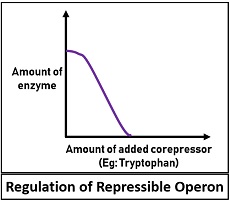
Enzymes whose synthesis is decreased by the increasing concentration of corepressor molecules are known as repressible enzymes. A gene system that regulates the enzyme synthesis via a corepressor is termed a repressible system. Thus, repressible operon in E.coli conducts the anabolic pathway like the production of amino acids.
Key Differences Between Induction and Repression
- The meaning of induction and repression states that the former will induce and the latter will repress the gene expression in the presence of inducer and corepressor, respectively.
- The induction operon stimulates enzyme synthesis due to enough inducer molecules or substrates in the surrounding. Contrarily, the repressor operon inhibits the enzyme synthesis due to the existing end-product or corepressor molecules.
- Inducer or anti-repressor metabolites and corepressor or effector molecules are the key elements of the induction and repression system.
- Inducer deactivates a repressor protein and prevents its attachment to the operator region. In contrast, a corepressor activates an apo-repressor protein (inactive) and facilitates the joining of an aporepressor to the operator region.
- An induction system activates or turns on the whole operon system under the adequate supply of the inducer metabolites. In contrast, a repression system terminates or switches off the whole operon system under the adequate level of pre-existing corepressor molecules.
- Lactose operon is the best example of an inducible operon, in which an adequate level of inducer molecules (allolactose) stimulates β-galactosidase (inducible enzyme) synthesis, necessary to split lactose into glucose and galactose. Oppositely, the tryptophan operon is the best example of a repressible operon that regulates the tryptophan synthesizing enzymes to construct tryptophan, and the addition of corepressor suppresses the trp synthesis.
- An inducible operon conducts a catabolic synthesis, where a complex molecule breaks down into simpler forms. In contrast, a repressible operon conducts an anabolic synthesis of a product after the combination of simple or smaller units.
Conclusion
Therefore, the induction and repression of the operon are the two mechanisms that regulate the synthesis of different enzymes and decides when to switch on or switch off the biosynthetic pathway.
It was very interesting and informative.